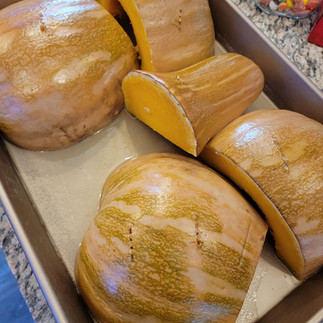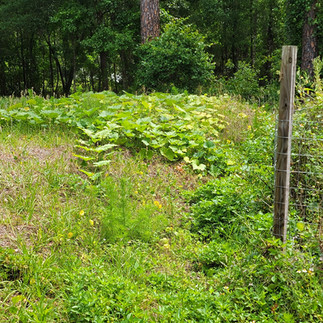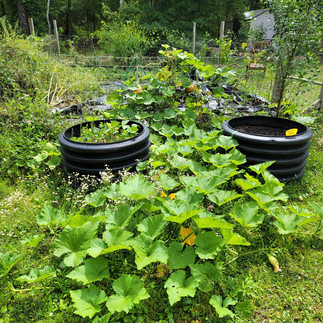We're growing Seminole Pumpkins again!
- Apr 21, 2024
- 4 min read
Updated: Jun 20, 2024
Guess who's back? Back again! Seminole Pumpkins, that's who!
What on earth is a Seminole Pumpkin you may ask?
Seminole pumpkins are a type of pumpkin native to Florida, particularly associated with the Seminole tribe, from which they take their name. These pumpkins are renowned for their resilience and adaptability to various growing conditions. They have a long history of cultivation by Native American tribes in Florida and were traditionally grown in the region for their nutritious flesh and seeds. Seminole pumpkins are known for their vine-like growth habit, which allows them to spread across large areas. They have a tough outer skin, making them resistant to pests and diseases, and they can be stored for extended periods. Seminole pumpkins are often used in cooking and can be roasted, baked, or used in soups and stews. They are prized for their sweet flavor and dense, creamy texture. Additionally, Seminole pumpkins are valued for their nutritional content, as they are rich in vitamins A and C, as well as fiber. Also, they are super super delicious, and we use them for everything here on our Homestead, where you'd typically use Pumpkins or Squash!
Let me tell you our Story of Seminole Pumpkins. It began as an idea around our dinner table really when we ate pumpkin pie that was less than... say, we shall stellar. With a little research we soon found that the ideal pumpkin for Florida does exist and soon we found ourselves hunting down legit seeds. Etsy to the rescue!
Upon their arrival, we planted 2 seeds; after all, we wanted to see how it did first and if the location we picked would work well. Fast forward about 3 months and we had Pumpkins everywhere! And I mean EVERYWHERE!
We harvested 400lbs of Pumpkins from two single seeds over the entire season.
If you are a Seminole Pumpkin lover, you may say to yourself, "But Mel, this doesn't look like a Seminole Pumpkin!" We questioned that for about 5 solid minutes as well but come to find out, Seminole Pumpkins come in all kinds of shapes. (You can read more about "The Seminole Pumpkin Project" done by David the Good, the Survival Gardener.) We happen to end up with a very prolific, delicious, long-neck variety.
How do you grow Seminole Pumpkins?
Growing Seminole pumpkins is relatively straightforward, and they are well-suited to a variety of growing conditions. Here's a basic guide to growing Seminole pumpkins:
Climate and Soil:
Seminole pumpkins thrive in warm climates, particularly in regions with long growing seasons. They prefer full sun and well-draining soil.
They are known for their tolerance to various soil types, including sandy, loamy, and clay soils. However, soil that is rich in organic matter and slightly acidic to neutral pH is ideal.
Planting:
Start by selecting a suitable location for planting. Ensure there's enough space for the vines to spread, as Seminole pumpkins can be quite vigorous - they will go ANYWHERE!!
Plant seeds directly into the ground after the last frost date in your area. Sow the seeds about 1 inch deep and 3 to 4 feet apart in rows or mounds.
You can also start seeds indoors 3-4 weeks before the last frost date and transplant the seedlings outdoors once the soil has warmed up and there is no risk of frost.
Watering:
Keep the soil consistently moist but not waterlogged, especially during the germination and fruiting stages. Water deeply to encourage strong root growth. When you grow these in Florida though, you can pretty much ignore that because our strong rainy season takes care of everything.
Mulching around the base of the plants can help retain soil moisture and suppress weeds.
Fertilization:
Seminole pumpkins are not heavy feeders but will benefit from occasional fertilization. Use a balanced fertilizer or compost at planting time and side-dress with compost or aged manure during the growing season. When we planted ours, we just put some compost in the holes, put the seeds on top, and covered them with dirt. We did not Fertilize them at all.
Support and Spacing:
While Seminole pumpkins can sprawl along the ground, providing support such as trellises or fences can help save space and keep the fruits off the ground, reducing the risk of rotting.
If you're growing them in rows, space the plants about 8 to 12 feet apart to allow for ample spreading. (We chaos garden and so the distance between the two seeds was more like 2 feet LOL)
Pest and Disease Management:
Seminole pumpkins are generally resistant to pests and diseases, but regular monitoring is still necessary. Handpick any pests you see, and treat any issues promptly. Ours had ZERO issues aside from one late in the season that got chewed on by a rodent or pecked by one of the chickens!
Harvesting:
Seminole pumpkins are typically ready for harvest 90 to 110 days after planting, depending on growing conditions.
Harvest pumpkins when the vines start to die back and the skin has hardened to a deep orange color. Cut the pumpkins from the vine, leaving a few inches of stem attached.
Store harvested pumpkins in a cool, dry place for several weeks to cure before using them. We did this and we still have about 30 Pumpkins in the pantry doing just fine :)
All instructions aside, they are incredibly easy to grow and will run to wherever you let them. Every vine will have little tendrils and will hold onto whatever it can grab to secure itself to the ground.
Ours didn't die over the winter and is back with new determination to take over the yard. Have at it Buddy, we're here for it!
If you find yourself in an abundance situation, check out one of our favorite recipes which is nothing short of amazing!


















Comments